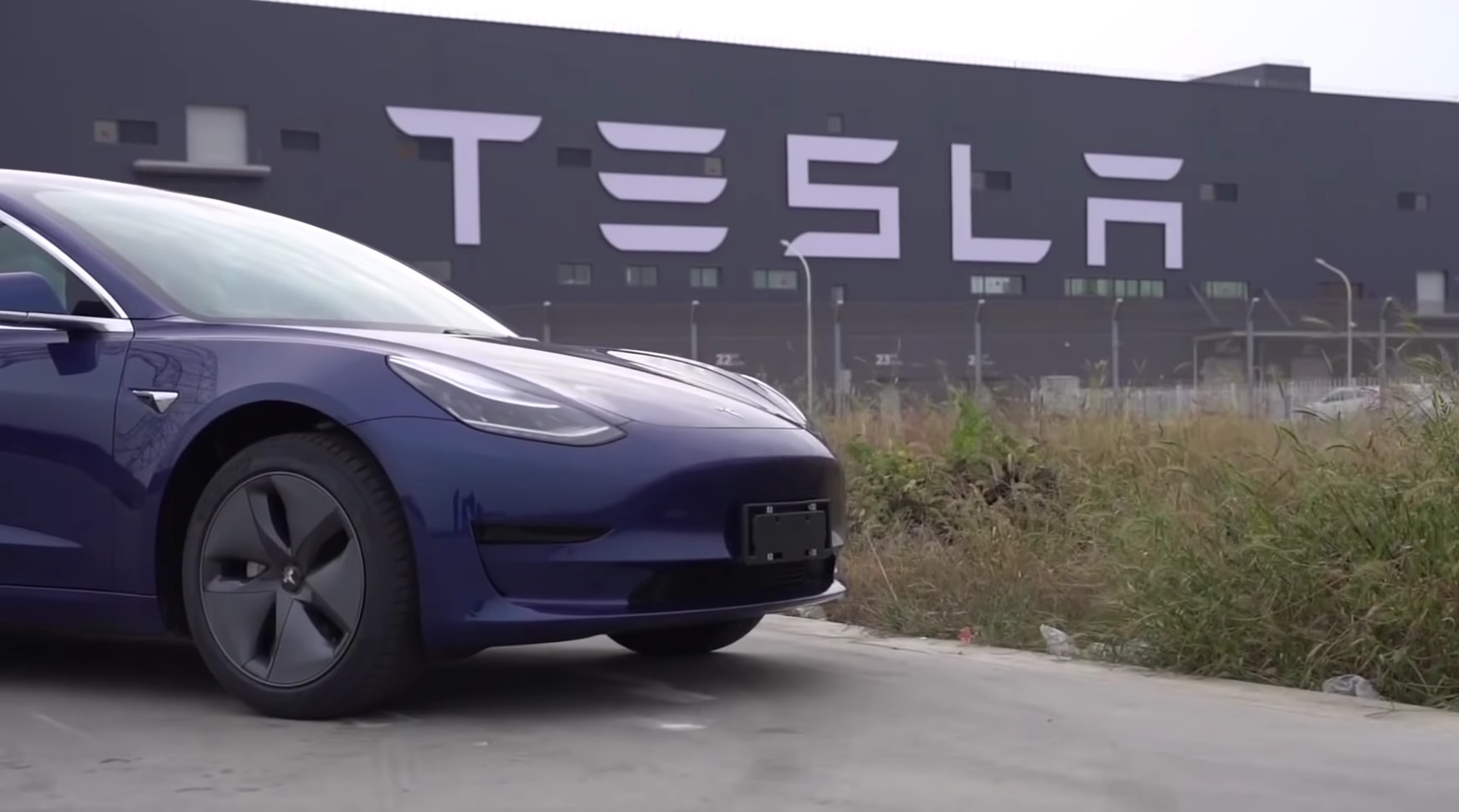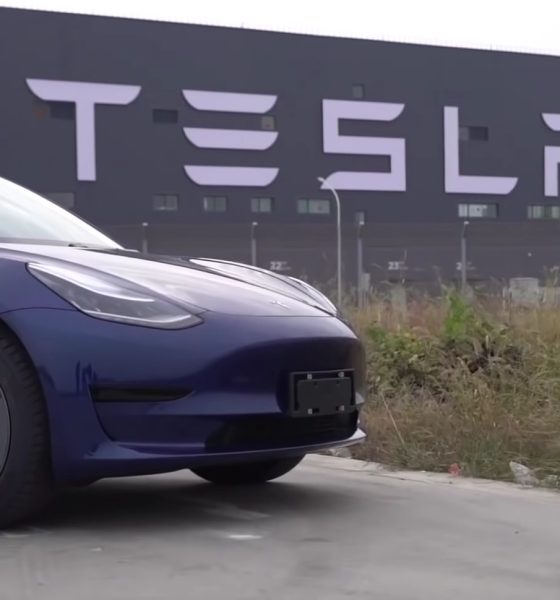

News
Tesla lowers price of China Model 3 to undercut BMW and Mercedes in strategic play
Tesla reduced the price of its Rear-Wheel Drive Made-in-China (MIC) Model 3 to RMB 299,050 or $42,919 after government subsidies. The price of the mass-produced electric sedan was initially pegged at $50,000, but in a surprise update on Friday, the Elon Musk-led electric carmaker lowered its price beneath a major psychological barrier of RMB 300,000, just days before the significant January 7 date. The price of the Dual Motor All-Wheel Drive Model 3 Long Range and Performance variant remains the same at 439,900 yuan ($63,086) and 509,900 yuan ($73,124), respectively.
The 16 percent price reduction on locally-produced Model 3 is made possible by new energy subsidies recently announced by the Chinese government. Tesla offers as much as RMB 24,750 savings for private purchases and RMB 17,325 for those operating new energy passenger cars. The Tesla China website now displays the adjusted prices of the locally-made Model 3s.
Tesla’s price reduction puts Model 3 in a category that’s strategically aimed at the entry-level luxury sedan category, with concentrations on Mercedes C Class and BMW 3 Series.
The question is if you were a Chinese customer, what would you buy?
1. A Tesla Model 3 starting at ¥299,050
2. A BMW 3 Series starting at ¥313,900
3. A Mercedes C300 starting at ¥308,000— Legacy 🚗 is f**ked (@tesla4k) January 3, 2020
Here comes the first order confirmation right after MIC #Model3 price drop today. More sales are on the way. Now Model 3 costs less than Merc C Class and BMW 3 Series. More young ppl will be able to afford Model 3s. Shoutout to @elonmusk @teslacn pic.twitter.com/A5S8qWcrif
— Ray (@ray4tesla) January 3, 2020
The latest development follows the announcement of the electric carmaker that the second round of Made-in-China Model 3 deliveries will happen on Jan. 7 at the Gigafactory Shanghai facility where the first 15 units of the mass-produced electric sedan were symbolically handed over to employees of Tesla.
The company also revealed during the Gigafactory 3 Delivery Ceremony that 30 percent of the parts used to build the Model 3 in China is locally-sourced, but with plans to completely localize its supply chain and open the possibility to more price adjustments in the future.
The cheaper entry-level Model 3 can help Tesla lure more customers away from local electric car makers and global brands in the largest EV market in the world. Tesla believes China could become the biggest market for its Model 3 and it might well be a key market that can help it achieve sustained profitability.
Recently, Tesla also announced that the Gigafactory 3 in Shanghai has achieved its Model 3 production goal and has been rolling out 280 cars per 10-hour shift or roughly 1,500 units a week. It plans to ramp up production and will likely hit 3,000 Model 3 a week when more production workers join the frontline.
The China arm of the Palo Alto, California-based company has been doing a hiring spree to add more people to help in different production line positions such as quality control, welding, painting, powertrain, and assembly, among others.
The first deliveries of the Made-in-China Model 3 happened exactly 357 days after the Gigafactory facility broke ground, an amazing feat for the first car plant in China wholly owned by a foreign carmaker.

News
Tesla FSD fleet is nearing 7 billion total miles, including 2.5 billion city miles
As can be seen on Tesla’s official FSD webpage, vehicles equipped with the system have now navigated over 6.99 billion miles.

Tesla’s Full Self-Driving (Supervised) fleet is closing in on almost 7 billion total miles driven, as per data posted by the company on its official FSD webpage.
These figures hint at the massive scale of data fueling Tesla’s rapid FSD improvements, which have been quite notable as of late.
FSD mileage milestones
As can be seen on Tesla’s official FSD webpage, vehicles equipped with the system have now navigated over 6.99 billion miles. Tesla owner and avid FSD tester Whole Mars Catalog also shared a screenshot indicating that from the nearly 7 billion miles traveled by the FSD fleet, more than 2.5 billion miles were driven inside cities.
City miles are particularly valuable for complex urban scenarios like unprotected turns, pedestrian interactions, and traffic lights. This is also the difference-maker for FSD, as only complex solutions, such as Waymo’s self-driving taxis, operate similarly on inner-city streets. And even then, incidents such as the San Francisco blackouts have proven challenging for sensor-rich vehicles like Waymos.
Tesla’s data edge
Tesla has a number of advantages in the autonomous vehicle sector, one of which is the size of its fleet and the number of vehicles training FSD on real-world roads. Tesla’s nearly 7 billion FSD miles then allow the company to roll out updates that make its vehicles behave like they are being driven by experienced drivers, even if they are operating on their own.
So notable are Tesla’s improvements to FSD that NVIDIA Director of Robotics Jim Fan, after experiencing FSD v14, noted that the system is the first AI that passes what he described as a “Physical Turing Test.”
“Despite knowing exactly how robot learning works, I still find it magical watching the steering wheel turn by itself. First it feels surreal, next it becomes routine. Then, like the smartphone, taking it away actively hurts. This is how humanity gets rewired and glued to god-like technologies,” Fan wrote in a post on X.
News
Tesla starts showing how FSD will change lives in Europe
Local officials tested the system on narrow country roads and were impressed by FSD’s smooth, human-like driving, with some calling the service a game-changer for everyday life in areas that are far from urban centers.

Tesla has launched Europe’s first public shuttle service using Full Self-Driving (Supervised) in the rural Eifelkreis Bitburg-Prüm region of Germany, demonstrating how the technology can restore independence and mobility for people who struggle with limited transport options.
Local officials tested the system on narrow country roads and were impressed by FSD’s smooth, human-like driving, with some calling the service a game-changer for everyday life in areas that are far from urban centers.
Officials see real impact on rural residents
Arzfeld Mayor Johannes Kuhl and District Administrator Andreas Kruppert personally tested the Tesla shuttle service. This allowed them to see just how well FSD navigated winding lanes and rural roads confidently. Kruppert said, “Autonomous driving sounds like science fiction to many, but we simply see here that it works totally well in rural regions too.” Kuhl, for his part, also noted that FSD “feels like a very experienced driver.”
The pilot complements the area’s “Citizen Bus” program, which provides on-demand rides for elderly residents who can no longer drive themselves. Tesla Europe shared a video of a demonstration of the service, highlighting how FSD gives people their freedom back, even in places where public transport is not as prevalent.
What the Ministry for Economic Affairs and Transport says
Rhineland-Palatinate’s Minister Daniela Schmitt supported the project, praising the collaboration that made this “first of its kind in Europe” possible. As per the ministry, the rural rollout for the service shows FSD’s potential beyond major cities, and it delivers tangible benefits like grocery runs, doctor visits, and social connections for isolated residents.
“Reliable and flexible mobility is especially vital in rural areas. With the launch of a shuttle service using self-driving vehicles (FSD supervised) by Tesla in the Eifelkreis Bitburg-Prüm, an innovative pilot project is now getting underway that complements local community bus services. It is the first project of its kind in Europe.
“The result is a real gain for rural mobility: greater accessibility, more flexibility and tangible benefits for everyday life. A strong signal for innovation, cooperation and future-oriented mobility beyond urban centers,” the ministry wrote in a LinkedIn post.
News
Tesla China quietly posts Robotaxi-related job listing
Tesla China is currently seeking a Low Voltage Electrical Engineer to work on circuit board design for the company’s autonomous vehicles.

Tesla has posted a new job listing in Shanghai explicitly tied to its Robotaxi program, fueling speculation that the company is preparing to launch its dedicated autonomous ride-hailing service in China.
As noted in the listing, Tesla China is currently seeking a Low Voltage Electrical Engineer to work on circuit board design for the company’s autonomous vehicles.
Robotaxi-specific role
The listing, which was shared on social media platform X by industry watcher @tslaming, suggested that Tesla China is looking to fill the role urgently. The job listing itself specifically mentions that the person hired for the role will be working on the Low Voltage Hardware team, which would design the circuit boards that would serve as the nervous system of the Robotaxi.
Key tasks for the role, as indicated in the job listing, include collaboration with PCB layout, firmware, mechanical, program management, and validation teams, among other responsibilities. The role is based in Shanghai.
China Robotaxi launch
China represents a massive potential market for robotaxis, with its dense urban centers and supportive policies in select cities. Tesla has limited permission to roll out FSD in the country, though despite this, its vehicles have been hailed as among the best in the market when it comes to autonomous features. So far, at least, it appears that China supports Tesla’s FSD and Robotaxi rollout.
This was hinted at in November, when Tesla brought the Cybercab to the 8th China International Import Expo (CIIE) in Shanghai, marking the first time that the autonomous two-seater was brought to the Asia-Pacific region. The vehicle, despite not having a release date in China, received a significant amount of interest among the event’s attendees.








